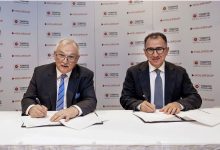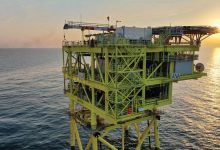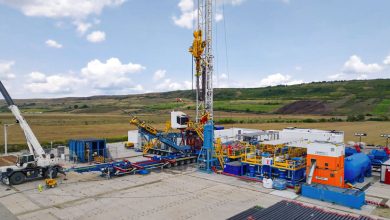Divergent developments in h1 2017
The oil and gas industry in Central and Eastern Europe (CEE) had weaker development, overall, than the rest of the economy in the first half of 2017, as shown by the analysis of the stock markets indices. The Russian oil and gas companies have negatively influenced the development of the regional index (STOXX Eastern Europe 300 oil & gas), given the effects of falling production as a result of the agreement reached with OPEC at the end of the previous year. In contrast, the European companies integrated in the respective index, including the Romanian ones, have pushed the index upwards, the prices of their shares on the stock markets comprising the good results, supported by the increase in oil prices in the first part of the year.
CEE oil & gas industry, under pressure on the stock markets
The STOXX Eastern Europe 300 oil & gas index had lost, at mid-2017, more than 10% against the end of 2016; the index, calculated by the STOXX LTD agency, mirrors the overall evolution of the major oil and gas companies in Eastern Europe, including Russia and Turkey (25 companies), traded on the stock markets in those countries; by comparison, the STOXX Eastern Europe 300 index, which reveals the overall economic development in the region, including the most important 300 representative companies for all economic fields (and thus a benchmark for eastern europe’s overall economic development, including Russia and Turkey) was at the end of june at approximately the same level as at the end of last year (see the graph ‘oil and gas industry, weak performance in the first half of the year’).
The figures show, therefore, that the oil and gas industry in this region had weaker performance on the stock markets than the rest of the economy as a whole in the first six months of 2017; this is, on one hand, the effect of the movements on the oil market and, on the other hand, a result of the high share of russian companies in the regional sectoral index.
Contradictory results
Thus, in an in-depth analysis of the STOXX Eastern Europe 300 oil & gas index, it can be noticed that the entities in its structure had divergent developments, depending on the geographic area (or, more precisely, the economic area) they are part of. More precisely, the shares of the Eastern European and Turkish companies registered positive developments (some of them rather spectacular), the Russian companies’ ones experienced decreases altogether (see the graph ‘divergent developments within STOXX 300 oil & gas index’).
Not surprisingly, the evolution of Russian companies, totally different from that of companies in the rest of the region, is mainly a result of the agreement reached by OPEC and the non-OPEC countries at the end of 2016 – an agreement to cut oil output.
Russia’s commitment in this agreement has therefore led to output cuts for the national companies (or to maintaining them at low levels), nevertheless, the positive evolution of oil prices following the agreement did not compensate for the drop in volumes.
According to estimates by the us energy information administration (eia) at the end of march 2017, Russia’s oil output was by about 177,000 barrels a day lower than the peak reached in november 2016 – following the agreement with OPEC; the continued decrease in production (by 300,000 barrels per day) was ongoing under the same agreement – valid until 2018.
This is the context in which the russian oil and gas companies experienced poorer performance in the first three months of the year against the same period in the previous year, below analysts’ expectations. Among these, novatek, for example, reported a decrease in total hydrocarbon output, down from 139.5 million barrels of oil equivalent in march 2016 to 127.7 million at end-march 2017; the production of liquid hydrocarbons (including oil) declined from 3.2 million tonnes (in q1 2016) to 2.9 million tonnes in q1 2017. On this background, the company’s net profit dropped in q1 2017 by 38% against the same period of the previous year, from 115 to 71 billion rubles (1 eur = about 68 Russian rubles (rub) at the end of june 2017).
Rosneft had also experienced a drop-in production at the end of q1 2017 – as compared to the peak levels recorded in october 2016… Although it recorded an advance of about 13% against the same period of the previous year (the growth being driven by the fact that bashneft has been recently taken over). The report published by the company therefore reveals the negative impact on production generated by meeting the terms of the agreement with OPEC. In figures, the company has reported a profit of about 13 billion rubles in q1, by about 8% higher than in q1 2016, but significantly below the analysts’ expectations; according to a survey conducted by Reuters with 10 specialists, quoted by the financial times, the expected profit for q1 2017 was of rub 22 billion (considering also the bashneft effect).
Russian gas giant Gazprom also reported capping of oil output in q1 – it was explained by the company as being in line with the annual output cuts plan and by a series of effects of the current operations in refining area; the company made no reference to the possible effects of the OPEC agreement!
Gazprom reported a net profit of about rub 333 billion in q1 2017, according to ifrs reports posted on its website, by about 8% lower than in the same period last year (rub 362 billion), and stagnancy of oil output. Thus, while in the gas segment the company reported a 12% increase in production for q1 2017 as compared to q1 2016 (from 113 to 127 billion cubic meters), the oil output increased only by 6%, from 11.3 to 12 million tonnes – clearly not enough to offset the drop-in oil prices which started at the end of march.
Lukoil, one of the most important oil producers in Russia (and not only!), also reported in the first quarter of the year a drop in the production of liquid hydrocarbons (oil included), from more than 2 million barrels of oil equivalent per day (boe/day) to a little bit more than 1.8 million boe/day, explained by the company, among others, by aligning itself to the conditions imposed by the agreement with OPEC.
“the liquid hydrocarbon production at group level declined by 7% in q1 2017 against q1 2016, mainly as a result of cuts in volumes resulting from west qurna-2 project operations, but also as a result of output cuts imposed by the agreement with opec,” reads the report published by the company’s management on its website. It is true, however, that Lukoil compensated for the decline in oil production with revenues from other areas – therefore it managed to achieve in q1 2017 sales of about rub 1,431.5 billion (against rub 1,177.7 billion in q1 2016) and a net profit of rub 62.3 billion (against rub 42.8 billion in q1 2016).
However, these positive financial developments failed to offset the investors’ negative outlook regarding the company’s stock market position as a result of the fall in oil prices (which have been on a downward trend since the end of march) and as result of the pessimism on the market regarding the level at which it could get stabilized. Hence, a negative perspective on the company’s future development, shared by some company officials – according to international media, by Alexander Matytsyn – vice-president of the company: “Lukoil takes into account the possibility that the oil price will remain at an average level about USD 40 per barrel in 2017, and the likelihood of decline in total production by about 1% in 2017 as a result of the agreements with OPEC.”
The effort made by Russian companies has led, in spite of a considerable increase in oil prices in early 2017, to rather negative results; the reports, released at the end of april and may, overlapped a strong correction of oil prices (starting with the first days of march) and the agreement to maintain low production levels set by the agreement signed in december 2016, still in force; as low prices and low levels of production set the prerequisites for weaker financial results – the negative trend of Russian companies on the stock markets has grown.
Europe’s leaders in terms of growth
Unlike the russian companies, the other companies in the stoxx eastern europe 300 oil & gas index registered positive developments on the stock markets in h1 2017, without exception. They benefited, on the one hand, from the price increase in early 2017 and, on the other hand, as a result of the increase in consumption, following the positive trend of the european economy.
By far, the best performance was experienced by the Greek company Hellenic Petroleum’s shares, with a higher stock market value by about 90% in six months, supported, among other things, by the very good results reported in q1.
Hellenic petroleum, Greece’s largest oil refiner, reported 35% increase in profit before tax, amortization and depreciation (ebitda) in q1, given the increase in refined raw material and the increase in demand, as well as an increase of about 80% of the net profit, both of them significantly exceeding the analysts’ estimates.
Tracing hellenic, with 30% to 50% market price increase, are the Czech company Unipetrol, the Turkish Türkiye petrol rafinerileri (in short – tüpras), Motor Oil Hellas (also from greece) and the polish operator Grupa Lotos; these developments on the stock markets are also supported by good financial results in q1 2017.
Thus, e.g. Unipetrol – the largest integrated petrochemical group in the Czech Republic – recorded a spectacular evolution in q1 2017, from a loss of about czk 25 million in q1 2016 to a net profit of czk 3.3 billion in q1 2017, amid revenues growth from czk 17.6 billion (in q1 2016) to czk 29.8 billion (in q1 2017) (eur 1 = approximately czk 26 at the end of june 2017).
Motor Oil Hellas – the second Greek-owned company in theSTOXX Eastern Europe 300 oil & gas index – also reported in q1 a net profit of about eur 90 million, by 83% higher than the one reported in the same period last year. The company also recorded revenues growth from eur 1.41 billion to eur 1.97 billion.
Last but not least, the polish company Grupa Lotos – which at the end of june marked a 30% increase in shares price – reported in q1 2017 revenues of eur 1.27 billion (against eur 900 million in q1 2016) and a net profit of eur 95.8 million (against eur 24.3 million in the same period in 2016).
Equally spectacular is the development of Turkish companies in the index – despite an adverse local political climate. At the end of june, the Tüpras shares saw a 50% increase on the stock market amid an impressive operational performance: in the first three months of the year, Türkiye Petrol Rafinerileri processed 7,477 tons of raw material (against 7,006 in the same period of the previous year) and sold 7,215 tons of processed products (as compared to 6,191 tons in q1 2016). Supported also by the rising oil prices, the company had revenues of about 12.3 billion Turkish pounds (try) – double against tyr 6.2 billion in q1 2016) and a net profit about 10 times higher (try 876 million against try 83 million in q1 the previous year). Interesting is also the evolution of Turcas Petrol, whose shares have increased their value on the stock market by about 36% at the end of june against the end of the previous year, despite the fact that it reported a loss of try 22 million in q1 2017 (against a profit of try 15 million in q1 2016).
Romanian companies, upward
The same positive trend was also registered in the first six months of 2017 by the three Romanian companies in the index – Romgaz, Transgaz and OMV Petrom; their development was supported by the high dividend yields proposed for the financial year 2016 and, in particular, by the discussions on granting special dividends – by distributing the reserves built during the past years. These had a strong positive impact on the market prices, which lasted until mid-june, but the companies’ shares also had a strong support from the good financial results achieved during q1.
Romgaz, growing business
Romgaz – whose shares registered a market price increase of over 20% at end-june against the end of 2016, reported a net profit of ron 565.9 million in q1 2017 (by about 15% higher as compared to the same period in the previous year) for a turnover of about ron 1.5 billion – by about 10% higher than in q1 2016 (ron 1.36 billion); the rise in financial indices were consistent despite the decrease in methane gas production – down from 1.37 billion cubic meters extracted in q1 2016 to 1.33 billion in q1 2017, and of condensed gas – from 2,047 tons to 1,672 tons.
Profit almost double for Transgaz
Transgaz also had financial achievements able to support the positive evolution of the market price! The company recorded in the first three months of the year a net profit of about ron 320 million, by 86% higher than the one achieved in the same period of the previous year, amid the increase in exploitation revenues by 37% to the level of ron 638 million. According to the company’s release, the good results are the result of the increase in operation – respectively the increase of revenues from the reservation of transport capacity and from the increase in quantity of the transported gas (by 19% against the volume transported in the same period in 2016).
OMV Petrom, exceptional financial results
The largest romanian oil and gas company, OMV Petrom, has evolved in the same positive trend! Less spectacular in terms of share prices development – marking an increase of about 8% at the end of june against the end of 2016 (in the absence of discussions and hopes of granting special dividends, as in the case of the other two companies in the index); but really spectacular in terms of financial results: in q1 2017, the company reported a net profit of ron 618 million, more than double against the one registered in the same period in 2016 (ron 288 million), given the increase in sales value by 27%. The rise in world oil prices is one of the elements that have supported this positive development, along with the increase of natural gas and electricity traded volumes, the company’s press release reads.
Impact factors
It should be noted that the romanian companies’ shares retained a large part of the growth registered in this first half of the year, despite the significant corrections registered at the end of june, as a result of news that adversely influenced the local investment environment. Thus, if in the first part of the second quarter the local oil and gas companies were also supported by the prospect of distributing extraordinary dividends – the investors found at the end of the month this would not happen; the negative impact of eliminating the possibility of receiving special dividends overlapped with the corrections registered as a result of registering the data in order to receive the dividends distributed for the previous year’s profits – a natural correction with prices normally adjusted by approximately the amount of dividends… Which, however, was a bit broader this time.
Last but not least, a strong impact on the shares prices oil and gas companies traded on the bucharest market was given by the information on the possible nationalization of mandatory private pension funds (private pillar ii – privately managed). This information led to a wave of sales of the most liquid of shares on the bucharest stock exchange, obviously including the shares of oil and gas companies.
The future, good and bad
The second half is not clear, however. On one hand, from the point of view of the Russian companies included in the index, given the high likelihood of maintaining the output decided within the limits of the agreement with OPEC and the prerequisites for continuing the fall in oil prices, the potential is rather unfavourable. The continued downward trend of their shares prices is therefore to be taken into account.
On the other hand, the fall in fuel prices gives a positive impetus to the European oil and gas industry, which is however in a favourable context given by the obvious relaunch of the EU member states economies; this positive macroeconomic situation is able to support the growth of demand and consumption, with beneficial effects in the companies’ balance sheets.
At the index level, however, it is unlikely that the positive developments of european companies can offset the probable negative trend for the evolution of russian companies – companies that, by their weight and size, influence the development of the STOXX Eastern Europe 300 oil & gas; however, as the usd 40-barrel threshold has been already taken into account by the authorities and executives of Russia’s leading companies, pleasant surprises are not excluded in the second half.






